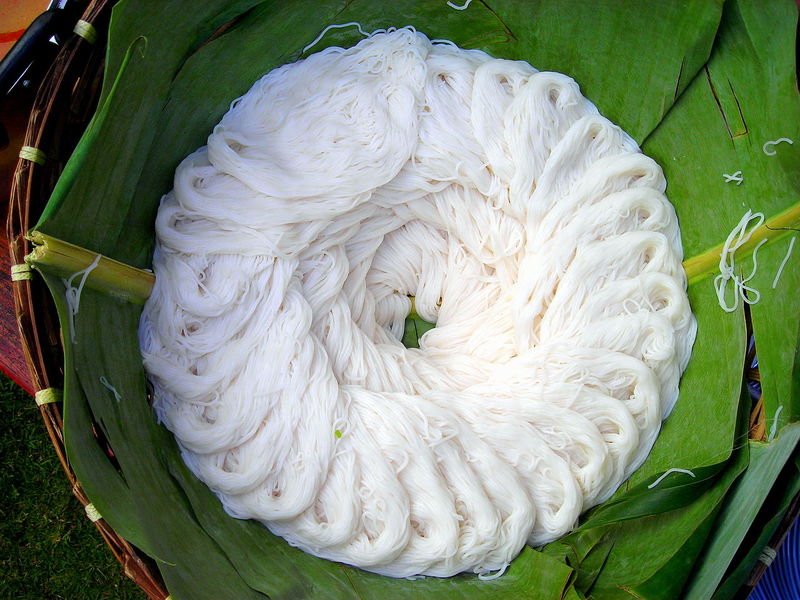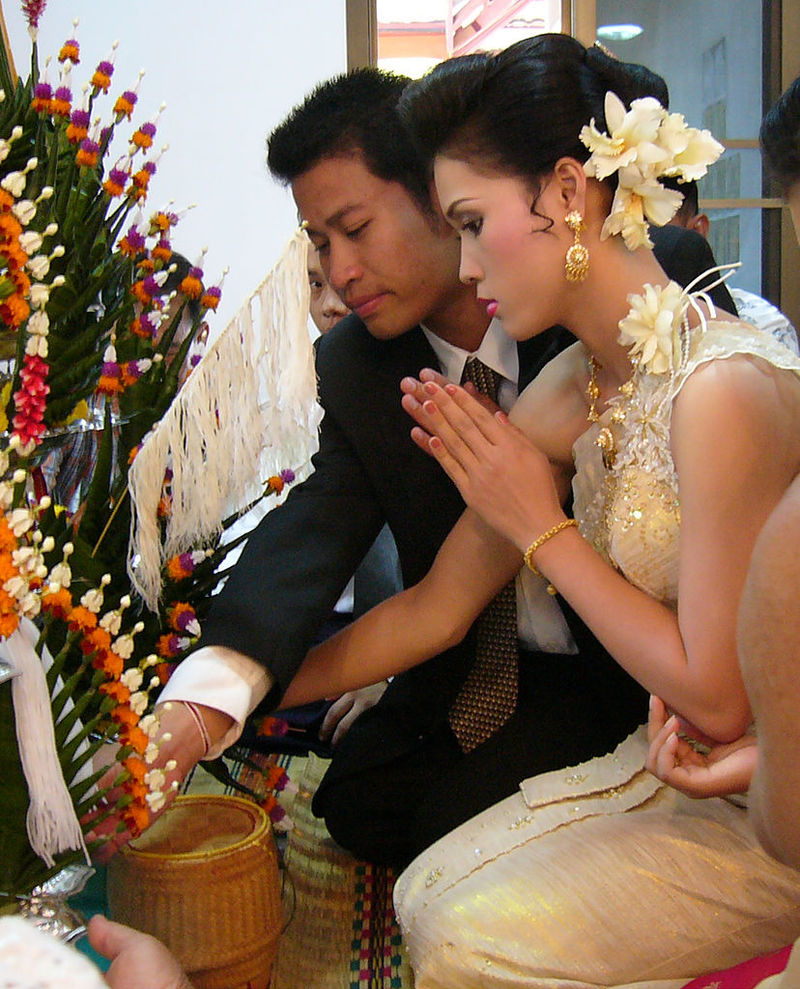Thai Wedding
Thai weddings blend traditional rituals with legal formalities, beginning with the agreement on the dowry ("sinsod") and a colorful "khan maak man" procession. Ceremonies often involve monks who bless the couple with holy water and white paste, followed by the symbolic opening of gates by the groom to signify his ability to care for the bride. Celebrations include the "Sai Monkhon" ritual, where the couple is blessed with a white thread, and end with a reception featuring symbolic foods and a special guest speech, concluding before midnight.
Thai Wedding
Before an engagement two families have to agree on the dowry ("sinsod"). After that a groom and his family create a procession which brings "khan maak man" ("objects of engagement"). There is lot of traditional music.
Probably the first thing a bride and groom have to decide is the date on which they are going to marry.
The same as in some other cultures Thai people require the help of an astrologist.
In Thailand it is believed that number 9 is the lucky one. Thai word for 9 is "gao". Two words sound similar. They are "kow-nah" which means progress and "khao" which is rice. That is why many people believe that it is quite good if there is this number in the date of the wedding or the time when the wedding ceremony is going to begin.
Ancestors are very important in the Thai society. So, it is not strange that on a day before the wedding couple participates in the ceremony dedicated to the bride's ancestors.

From the legal point of view the couple has to get married in the Amphur (District) Office. The religious ceremony is optional. The wedding reception is traditionally held in the house belonging to someone from two families.
A Thai bride traditionally wears light coloured slik dress. Nobody present at the Thai wedding wears black clothes.
Most Thai people are Buddhists. On the wedding day the couple invites monks. They pray and lit a candle placed in the bowl of water. This water is then used to bless the couple. Sometimes monks bless a special white paste. Little bit of this paste is put on the forehead of both bride and groom.
Monks then get some food. Nobody present can start eating before the monks finish up their food. After that monks pray once again. The supreme monk will then bless the couple and everyone else there with some holy water. As odd numbers are preferred in the Thai society 3, 5, 7 or 9 monks can arrive at the wedding. Each monk gets an envelope with some money.
Sometimes there is also a religiously influenced tradition where some animal is set free. The above mentioned "khan maak man" procession is nowadays often held on the wedding day after the departure of monks.
In front of the bride's house there is one or more symbolic gates. Usually there are 2 gates - golden ("pratoo tong") and silver ("pratoo ngoen"). A gate is actually a ribbon held by two women from the bride's family. A groom has to open gates to show that he will able to take care of a bride.
To open a gate one needs a key. In this case the key is an envelope with some money. Still often any amount won't do. There is lot of humour in this tradition.
After entering the bride's house the groom shows the presents he brought. These presents usually include some banana plants and golden jewelry. In the future these plants will serve as source of food for the baby. The plants are dedicated to the family ancestors too. The occasion is also used for the presentation of dowry ("sinsod") given by the groom to the bride's family.
What follows is the Sai Monkhon ritual. The couple with groom being to the right kneels in front of the oldest person from the bride's family or some respected person from the local community. He or she then uses a special white thread known as "sai monkhon" to connect bride's and groom's heads. After that they are blessed and small marking is made on their forhead.

Guests present at the wedding then use a conch shell ("sang") to bless the newlyweds by pouring holy water over their hands kept on the bowls filled with flowers. This tradition is called "rod nam sang" or "shell ritual". Each guest also put an envelope with money into a basket placed there for this purpose. In return everyone gets a small present.
The already mentioned white thread is thorn and a person who gets the longest peace has the biggest love. This tradition is called "Phiti Bai Sri Su Kwan".
Pieces of the white string ("sai sin") are tied to the wrist of couples presents at the wedding. They mean good luck. But one should wear them for three days to actually "function".
When arriving at the wedding reception one is greeted by the newlyweds. Sometimes a person will be asked to write couple of nice words in the notebook prepared for this purpose. Then a present is given. Usually it is an envelope with some money.
Apart of bride and groom there are several other stars of the wedding reception. One of them is the Master of Ceremony. He is someone close to the couple or he is a professional. One of his duties is to lead the ceremony of presentation of a wedding flower. The flower is given to the couple by groom's parents.
Most Thai weddings have a special guest who makes a short speech in which he or she wishes the couple all the best. There are many toasts too.
Lot of food is served. Each dish has a symbolic meaning. So, some are more favourable than others.
Let's take for example type of thin rice noodles called Khanom chin. They are symbols of long loving relationship. There are some dishes that are being avoided during wedding festivities. Tom yum (tom yam) soup is not served as it symbolizes serious troubles in marriage.
The wedding cake is cut by the newlyweds. As a sign of respect they first give slices to their parents, old family members and the special guest. A wedding reception in Thailand usually ends before midnight. Still some guest will continue to party in the nearby bar.
The newlyweds now go to their room to spend their first night together. But in some parts of Thailand they will be kind of surprised. Someone will be in their room. An old couple will be there to give them some advice. Several objects like for example coins and rice will be put on the bed. They symbolize a wish for the successful future. There is an extra condition. These objects should be there for 3 nights.
References
Traditional Thai Wedding
http://www.watdee.com/traditional-thai-wedding.html
Lucky Number 9
http://www.thaizer.com/culture-shock/lucky-number-9/
Traditional Thai Wedding
http://www.beachweddingthailand.com/wedding-guide/traditional-thai-wedding.php
Khanom chin
http://en.wikipedia.org/wiki/Khanom_chin
Image(s)
Traditional Thai wedding (photo by Bualong Sebulke)
Khanom chin noodles (photo by Mattes)
Creative Commons - File:Chiang-Mai Thailand Buddhist-Manuscript-Library-and-Museum-01.jpg